|
|
|
Sort Order |
|
|
|
Items / Page
|
|
|
|
|
|
|
| Srl | Item |
| 1 |
ID:
150108
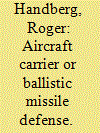

|
|
|
|
|
| Summary/Abstract |
Strategically, the United States is in a period characterized by uncertainty and diverse threats. Attempting to end two wars becomes background noise in the larger context of U.S. recalibration of its role in the world. U.S. power is perceived as either declining or being reoriented. Balancing off previous commitments with new ones becomes a critical and difficult task. The core problem becomes signaling commitment without deploying major forces to a particular location. Aircraft carriers are important symbolic instruments signaling U.S. interest regarding a particular issue. Those vessels are the linear descendants of battleships formerly the symbol of British power. Such deployments, however, are limited by being a ship, especially in disputes distant from the sea. Ballistic missile defense has come to occupy that role in signaling American commitment to allies or a state threatened by another. This can come as part of an alliance such as NATO's commitment of Patriot PAC-3 units to Turkey, with units drawn from three separate militaries including the United States.
|
|
|
|
|
|
|
|
|
|
|
|
|
|
|
|
| 2 |
ID:
150109
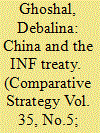

|
|
|
|
|
| Summary/Abstract |
Much has been said about the Intermediate Range Nuclear Forces (INF) Treaty; a treaty signed between the United States and the Soviet Union during the later stages of the Cold War. But, in the present times, both the United States and Russia have time and again accused each other of violating the treaty. Both parties have also suggested China be included in the treaty. This article discusses whether Beijing should be included in the INF Treaty and the factors associated with such entry.
|
|
|
|
|
|
|
|
|
|
|
|
|
|
|
|
| 3 |
ID:
150113
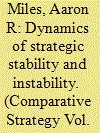

|
|
|
|
|
| Summary/Abstract |
I apply a dynamic systems approach to define strategic stability and classify strategic systems as stable, unstable, or neutral, based on the nature of forces that strategic capabilities exert under perturbation away from equilibrium. Conceptualizing stability in this manner is helpful when considering its relationship to mutual vulnerability, its role in extended deterrence relationships, and prospects for maintaining stability along proposed paths to disarmament. Traditional U.S. policy objectives do not appear to distinguish between true stability and neutral stability, and traditional definitions of strategic stability describe neutral stability. True strategic stability is an unlikely policy objective for the United States.
|
|
|
|
|
|
|
|
|
|
|
|
|
|
|
|
| 4 |
ID:
150106


|
|
|
|
|
| Summary/Abstract |
The People's Republic of China (PRC) and its rapidly evolving space forces are viewed to be one of the principal threats to the United States' national security space infrastructure and the U.S. capability for timely force projection in the Pacific Theater. This view, especially since the 2007 kinetic anti-satellite (ASAT) weapons test, added emphasis to the Space Posture Review of 2010 and the Department of Defense's quest for deterrence as a means to secure the sanctuary of space from weaponization. This article will examine the strategic culture of the PRC and how it impacts the space deterrence philosophies of both the PRC and the U.S. Department of Defense.
|
|
|
|
|
|
|
|
|
|
|
|
|
|
|
|
| 5 |
ID:
150115


|
|
|
|
|
| Summary/Abstract |
This article argues that NATO is unable to challenge any of President Putin's expansive policies for two key reasons: First, Europe and the United States have conflicting views on what events qualify as key security threats (different threat perceptions). Infused within this paradigm is a nascent European Union strategic culture that views threats differently from the U.S. This in turn undermines NATO, as the Europeans argue for largely nonmilitary or more peacekeeping-oriented approaches to respond to threats that are quintessentially multilateral. Second, even though there are major differences between the NATO states and Russia, the two most pressing issues before the Atlantic Alliance are Iran and Syria. The NATO states know that a resolution to the Syrian civil war or to Iran's nuclear program is unlikely without the support of Moscow, which limits their ability to effectively challenge Russia. This article concludes with a call for NATO to focus on identifying a new agenda for the Atlantic Alliance, one that is more human-security oriented, as it addresses the root causes of instability in and around the Eurozone.
|
|
|
|
|
|
|
|
|
|
|
|
|
|
|
|
| 6 |
ID:
150114
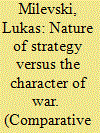

|
|
|
|
|
| Summary/Abstract |
Recent literature in strategic studies has argued for or against the idea that the world is entering an era of new types of conflict. Yet neither side of the debate appears to have considered the primary source of the character of war, which is strategy. Strategy's two main relationships (that between military power and political consequences, and that between interacting adversaries) contribute significantly toward determining the character of any war. Strategy is the basis both for understanding present wars and anticipating future wars. Although useful for defense planners and historians, for practicing strategists, “the character of war” lacks analytical value.
|
|
|
|
|
|
|
|
|
|
|
|
|
|
|
|
| 7 |
ID:
150110


|
|
|
|
|
| Summary/Abstract |
With rumblings that the Obama administration is considering an early extension to the New Strategic Arms Reduction Treaty, it is important to review the advantages and disadvantages to extending the treaty at this time. Moreover, in light of Russia's strategic and nonstrategic nuclear weapon investments, as well as its broader, destabilizing foreign policy, there are plenty of reasons to delay. Conversely, the transparency the treaty provides and the strategic ceilings it institutes have a special value unto their own. Pursuing an extension now is not in the best interests of the United States, while examining other policy options is prudent.
|
|
|
|
|
|
|
|
|
|
|
|
|
|
|
|
| 8 |
ID:
150112
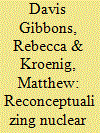

|
|
|
|
|
| Summary/Abstract |
According to a widespread conventional wisdom in the scholarly literature, the threat of nuclear weapons resides largely in the risk of accident, inadvertent use, and nuclear terrorism. In this article, we argue that this conventional wisdom is inconsistent with the increasing danger of nuclear use by leaders intentionally employing nuclear weapons as tools of statecraft. This article identifies the theoretical processes that could give rise to deliberate nuclear use. Next, it marshals empirical evidence through an examination of developments in several salient geopolitical rivalries between nuclear-armed actors in the world today, demonstrating that deliberate nuclear use may be becoming increasingly likely. Finally, it offers concluding remarks regarding the steps world leaders can take to deter and prevent intentional nuclear strikes. This article seeks to bring back in an appreciation of deliberate nuclear use to academic studies of nuclear deterrence and instructs policymakers on the appropriate understanding of the risks of nuclear weapons proliferation.
|
|
|
|
|
|
|
|
|
|
|
|
|
|
|
|
| 9 |
ID:
150111


|
|
|
|
|
| Summary/Abstract |
The existing literature suggests different ways to explain the interconnection between technology, military, and society that creates changes in military affairs. It seems, however, that most of this literature concentrates on successful cases of military transformations and overlooks a significant number of failed transformations. The purpose of this article is to define the conceptual social-political-military environment that creates, or not, military transformations in general, and revolutions in military affairs (RMAs) in particular. Supporting its argument with two historical examples, this article suggests that an RMA is an outcome of traceable imbalance between political leadership, its military, and unmet political-military challenges. The conceptual framework proposed by the article significantly improves the ability of scholars and practitioners to explore, explain, and anticipate the possible directions of military transformations by a systematic examination of the political-military challenges that these transformations are intended to bridge and the socio-cultural environments that shape political-military decision-making processes.
|
|
|
|
|
|
|
|
|
|
|
|
|
|
|
|
| 10 |
ID:
150107


|
|
|
|
|
| Summary/Abstract |
China has made a “developmental leap” with the Type 094 ballistic missile submarine (SSBN). The anticipated commencement of strategic patrols in 2015 will provide China with a credible sea-based nuclear deterrent. This deterrent represents a growing threat to the American people and a game changer for U.S.-Chinese strategic stability. How can the United States mitigate this threat and ensure strategic stability? The deployment of the Type 094 SSBN has many similarities with the deployment of Soviet DELTA-class SSBNs in the early 1970s. This study compares the DELTA case with the Type 094 and argues for a geography-based strategy to counter the deployment of Chinese SSBNs.
|
|
|
|
|
|
|
|
|
|
|
|
|
|
|
|
|
|
|
|
|